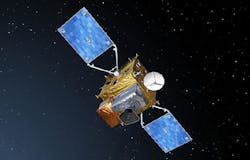e2v wins $3.7M Sentinel satellite imaging contract and Sir Arthur Clarke award
Chelmsford, England--Imaging solutions company e2v signed a contract worth $3.7 million dollars (2.8 million euros) with Astrium, Europe's leading space technology company. e2v will supply imaging sensors to equip the European Space Agency's (ESA) Sentinel 4 Ultraviolet Visible Near-infrared (UVN) instrument, which will gather data on the quality of the Earth’s atmosphere and its chemical composition from geostationary orbit.
Sentinel 4 is part of the Global Monitoring for Environment and Security (GMES) initiative, which is a joint undertaking of the European Commission and the ESA. It will deliver environmental and security services in Europe, in response to the ever-increasing demands for effective environmental policies. ESA is responsible for the Space component of GMES, of which the five families of Sentinel missions are key components. Within this program, Sentinel 4 will be carried into orbit onboard the Meteosat Third Generation (MTG) geostationary satellite and enable seamless observations of Europe and North Africa to be taken hourly.
e2v's space-qualified, custom charge-coupled device (CCD) image sensors will be produced using back illumination to deliver the best quantum efficiency (QE) and modulation transfer function (MTF) over the wavelength range of interest for this hyperspectral imaging system. The sensors are mounted in an e2v designed package assembly which manages the electrical, thermal, mechanical and optical interfaces to the instrument. The contract is carried out with funding from the European Union.
Hans Faulks, GM High Performances Imaging at e2v, said, "e2v is delighted to sign this contract with Astrium. It demonstrates how e2v's imaging technology for Earth observation applications is well recognised and adds to more than 100 Earth observation programmes running with our high performance imaging sensors."
In addition to the Sentinel contract award, e2v also won the Sir Arthur Clarke award for outstanding achievements by a team in space activities. The award was presented to e2v group director Richard Gibbs by Major Tim Peake (the first British citizen to be selected as an astronaut by ESA) at the UK Space Conference 2013 awards dinner in Glasgow, Scotland.
The Sir Arthur Clarke Award is an award given in recognition of notable contributions to space exploration, particularly British achievements and has been presented annually since 2005.
e2v was selected as the winner due to its outstanding contribution to space activities in the past year including arriving on Mars onboard NASA's Curiosity rover, going into orbit in Europe's highest-resolution satellite, Pleiades, and equipping the telescope of the extraordinary astronomy mission Gaia, which is due to launch in the next few months. Gibbs said, "It was a huge honour to be nominated for this award and we are thrilled to have actually won. In this past year we have seen a number of high profile space missions returning images and data using our image sensors. We are proud that the e2v team have been recognised for our outstanding work in this sector."
SOURCE: e2v; http://www.e2v.com/news/e2v-and-astrium-sign-a--2-8m-contract-for-e2v-to-supply-imaging-sensors-to-equip-the-sentinel-4-satellite/ and http://www.e2v.com/news/e2v-wins-sir-arthur-clarke-award-for-outstanding-achievement-in-space-activities/
About the Author

Gail Overton
Senior Editor (2004-2020)
Gail has more than 30 years of engineering, marketing, product management, and editorial experience in the photonics and optical communications industry. Before joining the staff at Laser Focus World in 2004, she held many product management and product marketing roles in the fiber-optics industry, most notably at Hughes (El Segundo, CA), GTE Labs (Waltham, MA), Corning (Corning, NY), Photon Kinetics (Beaverton, OR), and Newport Corporation (Irvine, CA). During her marketing career, Gail published articles in WDM Solutions and Sensors magazine and traveled internationally to conduct product and sales training. Gail received her BS degree in physics, with an emphasis in optics, from San Diego State University in San Diego, CA in May 1986.

